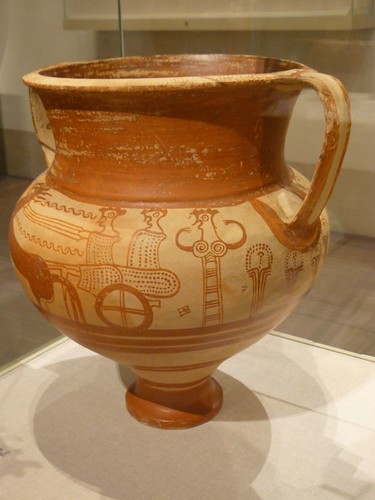In this post I will be identifying which Aegean culture created the Fisherman fresco and the terracotta Vessel. The Aegean world consisted of three main cultures; Cycladic 2500-1900 BCE, Minoan 2000-1400 BCE, and Mycenaean 1600-1100 BCE.
The Fisherman fresco resembles the Minoan culture, even though Minoans typically craved humans rather then paint them. Minoans usually painted marine life. One of the reasons I feel that this piece was created by Minoans is that the young man has two locks of youth similar to the Young Girl Gathering Saffron Crocus Flowers (101) who also has a lock of youth. The lock of youth indicating he is merely a child and the blue hair suggesting his hair has grown and he is more man then child. The colors used in the Fisherman fresco remind me of the colors used in other Minoan frescos; rose, blue, and yellow. These colors have been used in the Akrotiri, Thera palace frescos, for example the Spring Landscape (102) uses rose, blue and yellow. The dead fish are painted similarly to the dolphins in the “Flotilla” fresco (89), blue covers the top half of the fish and yellow covers the belly of the fish. The way the young man stands is in composite view with his head, hips and feet in profile and his chest and eye in a frontal view. Although this young fisherman does not have a pinched waste like the figures in the Bull Leaping fresco, the border around the piece is reminiscent of the simple border at the top of the fisherman piece. Another clue that this piece is a Minoan fresco is that the young boy has caught two bundles of fish. Minoan people were very interested in marine life because they lived on Crete and Thera which are islands near the Mediterranean Sea .
I think the terracotta vessel is most reminiscent of the Mycenaean culture. The shape of vessel is called krater because of its wide-mouth which would be used to mix water and wine. There is a register decorating the vessel, registers are used to narrate a story in art, many ancient cultures used this technique. Within this register is what looks like people. The people depicted are rather unusual looking and look more cartoon like. Mycenaean culture, unlike the Minoan culture, painted humans unrealistically. Although we can not see the entire krater, there are two figures riding what looks like a chariot pulled by a horse. The narrative is unknown yet there is a militaristic feeling given because of the chariot. The figure to the right of the chariot looks to be a woman holding her arm up which is a sign of power. The way that the vessel is painted strikes a resemblance to the Warriors Vase which also depicts men militaristically (111).
In conclusion these two pieces from the Aegean cultures can only be from one of three cultures, Cycladic, Minoan, or Mycenaean. I think that the Fisherman was a creation from the Minoan culture. I think that the terracotta krater was a creation from the Mycenaean culture.


